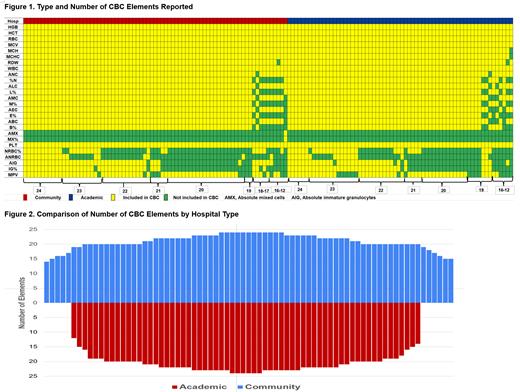Background
Complete blood count (CBC) is the most common test performed in hematology-oncology. A typical CBC report contains over 10 elements. Simplifying the report by removing nonessential elements may benefit clinicians and patients. Little is known about what elements are reported by various hospitals in the US. The objective of our study was to describe how hospitals in the US report CBC.
Methods
After approval from the Mayo Clinic institutional review board, we obtained hospital CBC reported elements from the Epic electronic medical records Care Everywhere health information exchange. CBCs from 2020-2023 were included. For each hospital, we determined the city and state where it's located. We obtained the number and type of elements reported in the CBC and compared the findings between academic and community hospitals.
Results
We collected CBC data from 139 hospitals across 43 states and 102 cities (Figure 1). Fifty-four percent were community hospitals while 46% were academic hospitals. The median number of elements reported by all hospitals was 21 (range, 12-24). This was not different (P=0.98) between academic (median 22 [range, 12-24]) and community hospitals (median 21 [range, 14-24]; Figure 2). The distribution of hospitals according to the number of CBC elements reported were as follows: 12-15 (6%), 16-19 (13%), 20 (25%), 21(6%), 22 (18%), 23 (19%), and 24 (13%). A minority of the hospitals did not report % white blood cell differential count (9.4%) or mean platelet volume (20.9%). Nucleated red blood cell and immature granulocyte count were reported frequently, 46.0% and 56.8%, respectively. However, the frequency of reporting these four elements were similar between academic and community hospitals.
Conclusions
We found substantial variations in CBC reporting among US hospitals even within academic and community hospitals. Most hospitals reported 20 or more elements, twice as many as the hospitals reporting the least number of elements. There is an opportunity to simplify and standardize CBC reporting, which will minimize physician burnout and distraction as well as decrease patient concern and query.
Disclosures
No relevant conflicts of interest to declare.


This feature is available to Subscribers Only
Sign In or Create an Account Close Modal